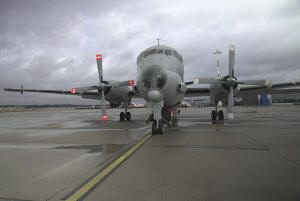At least 11 Baltic cables have been damaged in 15 months, prompting NATO
to up its guard
 Send a link to a friend
Send a link to a friend
 [January 28, 2025]
By JOHN LEICESTER and EMMA BURROWS [January 28, 2025]
By JOHN LEICESTER and EMMA BURROWS
ABOARD A FRENCH NAVY FLIGHT OVER THE BALTIC SEA (AP) — With its powerful
camera, the French Navy surveillance plane scouring the Baltic Sea
zoomed in on a cargo ship plowing the waters below — closer, closer and
closer still until the camera operator could make out details on the
vessel's front deck and smoke pouring from its chimney.
The long-range Atlantique 2 aircraft on a new mission for NATO then
shifted its high-tech gaze onto another target, and another after that
until, after more than five hours on patrol, the plane's array of
sensors had scoped out the bulk of the Baltic — from Germany in the west
to Estonia in the northeast, bordering Russia.
The flight's mere presence in the skies above the strategic sea last
week, combined with military ships patrolling on the waters, also sent
an unmistakable message: The NATO alliance is ratcheting up its guard
against suspected attempts to sabotage underwater energy and data cables
and pipelines that crisscross the Baltic, prompted by a growing
catalogue of incidents that have damaged them.
“We will do everything in our power to make sure that we fight back,
that we are able to see what is happening and then take the next steps
to make sure that it doesn’t happen again. And our adversaries should
know this," NATO Secretary-General Mark Rutte said this month in
announcing a new alliance mission, dubbed “Baltic Sentry,” to protect
the underwater infrastructure vital to the economic well-being of
Baltic-region nations.

What's under the Baltic?
Power and communications cables and gas pipelines stitch together the
nine countries with shores on the Baltic, a relatively shallow and
nearly landlocked sea. A few examples are the 152-kilometer (94-mile)
Balticconnector pipeline that carries gas between Finland and Estonia,
the high-voltage Baltic Cable connecting the power grids of Sweden and
Germany, and the 1,173-kilometer (729-mile) C-Lion1 telecommunications
cable between Finland and Germany.
Why are cables important?
Undersea pipes and cables help power economies, keep houses warm and
connect billions of people. More than 1.3 million kilometers (807,800
miles) of fiber optic cables — more than enough to stretch to the moon
and back — span the world's oceans and seas, according to TeleGeography,
which tracks and maps the vital communication networks. The cables are
typically the width of a garden hose. But 97% of the world’s
communications, including trillions of dollars of financial
transactions, pass through them each day.
“In the last two months alone, we have seen damage to a cable connecting
Lithuania and Sweden, another connecting Germany and Finland, and most
recently, a number of cables linking Estonia and Finland. Investigations
of all of these cases are still ongoing. But there is reason for grave
concern," Rutte said on Jan. 14.
What's causing alarm?
At least 11 Baltic cables have been damaged since October 2023 — the
most recent being a fiber optic cable connecting Latvia and the Swedish
island of Gotland, reported to have ruptured on Sunday. Although cable
operators note that subsea cable damage is commonplace, the frequency
and concentration of incidents in the Baltic heightened suspicions that
damage might have been deliberate.
There also are fears that Russia could target cables as part of a wider
campaign of so-called “hybrid warfare” to destabilize European nations
helping Ukraine defend itself against the full-scale invasion that
Moscow has been pursuing since 2022.
Without specifically blaming Russia, Rutte said: “Hybrid means sabotage.
Hybrid means cyber-attacks. Hybrid means sometimes even assassination
attacks, attempts, and in this case, it means hitting on our critical
undersea infrastructure.”
[to top of second column]
|

Pilot Lt. Terry (surname withheld by the French military) inspects
the wheels of a French Navy Atlantique 2 surveillance plane before
its takeoff from Hamburg, Germany, Thursday, Jan. 23, 2025, on a
NATO patrol over the Baltic Sea as part of the military's alliance
"Baltic Sentry" mission to protect undersea cables and pipelines
from sabotage. (AP Photo/John Leicester)

Finnish police suspect that the Eagle S, an oil tanker that damaged
the Estlink 2 power cable and two other communications cables
linking Finland and Estonia on Dec. 25th, is part of Moscow’s
“shadow fleet” used to avoid war-related sanctions on Russian oil
exports.
Finnish authorities seized the tanker shortly after it left a
Russian port and apparently cut the cables by dragging its anchor.
Finnish investigators allege the ship left an almost 100-kilometer
(62-mile) long anchor trail on the seabed.
Intelligence agencies' doubts
Several Western intelligence officials, speaking on condition of
anonymity because of the sensitive nature of their work, told The
Associated Press that recent damage was most likely accidental,
seemingly caused by anchors being dragged by ships that were poorly
maintained and poorly crewed.
One senior intelligence official told AP that ships' logs and
mechanical failures with ships' anchors were among “multiple
indications” pointing away from Russian sabotage. The official said
Russian cables were also severed. Another Western official, also
speaking anonymously to discuss intelligence matters, said Russia
sent an intelligence-gathering vessel to the site of one cable
rupture to investigate the damage.
The Washington Post first reported on the emerging consensus among
U.S. and European security services that maritime accidents likely
caused recent damage.
Cable operators advise caution
The European Subsea Cables Association, representing cable owners
and operators, noted in November after faults were reported on two
Baltic links that, on average, a subsea cable is damaged somewhere
in the world every three days. In northern European waters, the main
causes of damage are commercial fishing or ship anchors, it said.
In the fiber-optic cable rupture on Sunday connecting Latvia and
Sweden, Swedish authorities detained a Maltese-flagged ship bound
for South America with a cargo of fertilizer.
Navibulgar, a Bulgarian company that owns the Vezhen, said any
damage was unintentional and that the ship's crew discovered while
navigating in extremely bad weather that its left anchor appeared to
have dragged on the seabed.

NATO's ‘Baltic Sentry’ mission
The alliance is deploying warships, maritime patrol aircraft and
naval drones for the mission to provide “enhanced surveillance and
deterrence.”
Aboard the French Navy surveillance flight, the 14-member crew
cross-checked ships they spotted from the air against lists of
vessels they had been ordered to watch for.
“If we witness some suspicious activities from ships as sea – for
example, ships at very low speed or at anchorage in a position that
they shouldn’t be at this time – so this is something we can see,”
said the flight commander, Lt. Alban, whose surname was withheld by
the French military for security reasons.
“We can have a very close look with our sensors to see what is
happening.”
___
Burrows reported from London. AP journalists Jill Lawless in London,
David Klepper in Washington and Veselin Toshkov in Sofia, Bulgaria,
contributed to this report.
All contents © copyright 2025 Associated Press. All rights reserved |